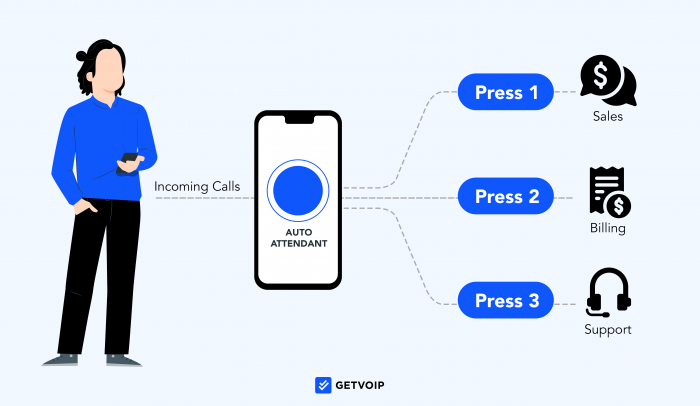Business VoIP features like auto attendants streamline the customer experience by helping callers get the information they need or reach the support agent best-suited to help them.
Here, we’ll outline how auto attendants work along with the best auto attendant phone systems that improve customer satisfaction.
- Overview
- How Auto Attendants Work
- How to Set Up
- Auto Attendant vs IVR
- Pros & Cons
- Choosing a Provider
- Best Auto Attendants
What is an Auto Attendant?
An auto attendant is a business phone system feature that automatically answers, greets, and routes inbound calls based on the caller’s response to a self-service menu.
Also called intelligent virtual receptionists (IVR) or auto-receptionists, they connect the caller to the best-available agent or department based on information they provide via speech, dial pad entry, or the specific phone number dialed.
Multi-level auto attendants automatically play pre-recorded messages that give the caller additional options after they’ve indicated which department or agent they need. In addition to helping agents during peak call volume, auto attendants provide self-service that often prevents callers from requiring a live agent.
By utilizing pre-set IVR call flows, auto attendants can:
- Help callers identify the department they want to reach
- Prevent inbound callers from hanging up or disconnecting
- Forward unanswered calls to voicemail or another agent
- Automatically transfer and route inbound calls
- Provide callers with key information like hours, location, or weather/COVID updates
- Hold calls until a live agent is available
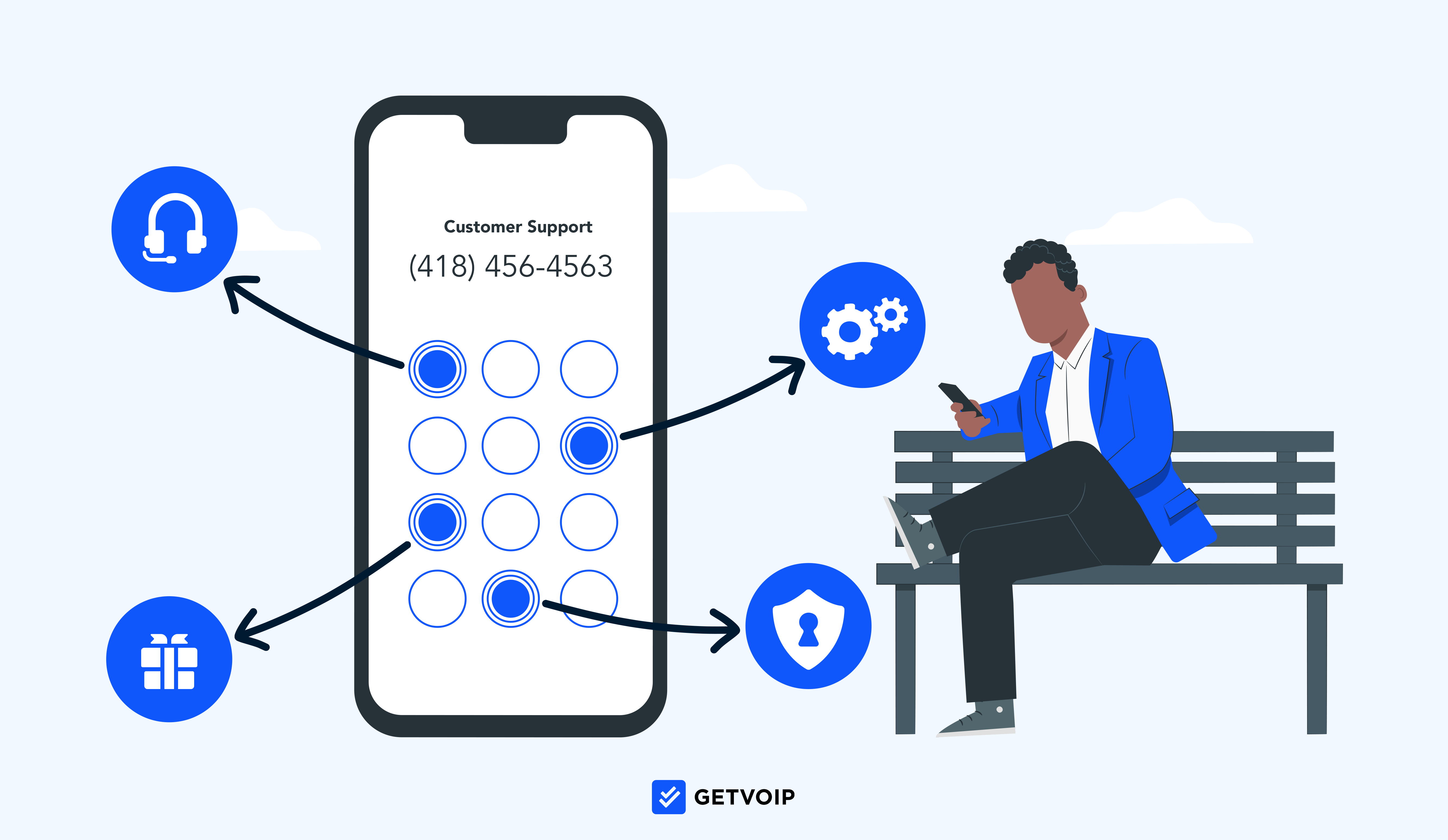
How Does an Auto Attendant Work?
Here’s how an auto attendant works:
- Greets inbound callers who dial a particular number: When the caller dials the number linked to the auto attendant, the call connects. The auto attendant plays the pre-recorded greeting or voices the type-to-talk message.
- Announces menu options and routing choices: After the greeting, the auto attendant narrates the routing menu options. For example, “Press 1 for Sales, Press 2 for Billing, Press 3 for Technical Support,” etc.
- Caller selects a menu option: After hearing the menu options, the caller indicates their intended destination using a dual-tone multi-frequency (DTMF) selection or voicing the menu selection out loud.
- Auto attendant announces sub-menu options: If the caller’s choice leads to additional options, the auto attendant voices the submenu options
- Caller makes submenu selection: The caller makes a selection from the submenu options, using the same DTMF or voice method as before
- Auto attendant routes call to user, voicemail, or audio message: Depending on the caller’s choice, the auto attendant either routes the call to a user, a queue, or plays an announcement. If the user is unavailable, the auto attendant can place the call in a waiting queue or route it to voicemail.
- Hang up: When the call is completed or the caller has heard the announcement, the auto attendant or caller hangs up the phone
How to Set Up an Auto Attendant
The process for setting up an auto attendant varies by provider, but it typically involves the following steps:
- Assign menu options: In your phone system software’s auto attendant settings, assign a routing destination to each keypad number, 1-9. You can route calls to an agent, department, voicemail, audio announcement, or ring group.
- Record greeting and menu options: Record audio or use text-to-talk to record a menu that communicates routing options to inbound callers. Add announcements or multiple levels of menu options.
- Create call groups or queues: If you’d like to group multiple adults together to share responsibility, build call groups or create queues in your phone system settings
- Set business hours: Customize your menu options, announcements, and routing based on business hours or agent availability
- Configure timeout settings: Set options to redirect the caller to the main menu, voicemail, or hang up if calls remain unanswered for a select period of time
- Save settings and test: Test your auto attendant menu to make sure everything runs smoothly
- Improve menu over time: Use any available data, queue volume statistics, and customer feedback to continually refine your auto attendant for customer satisfaction
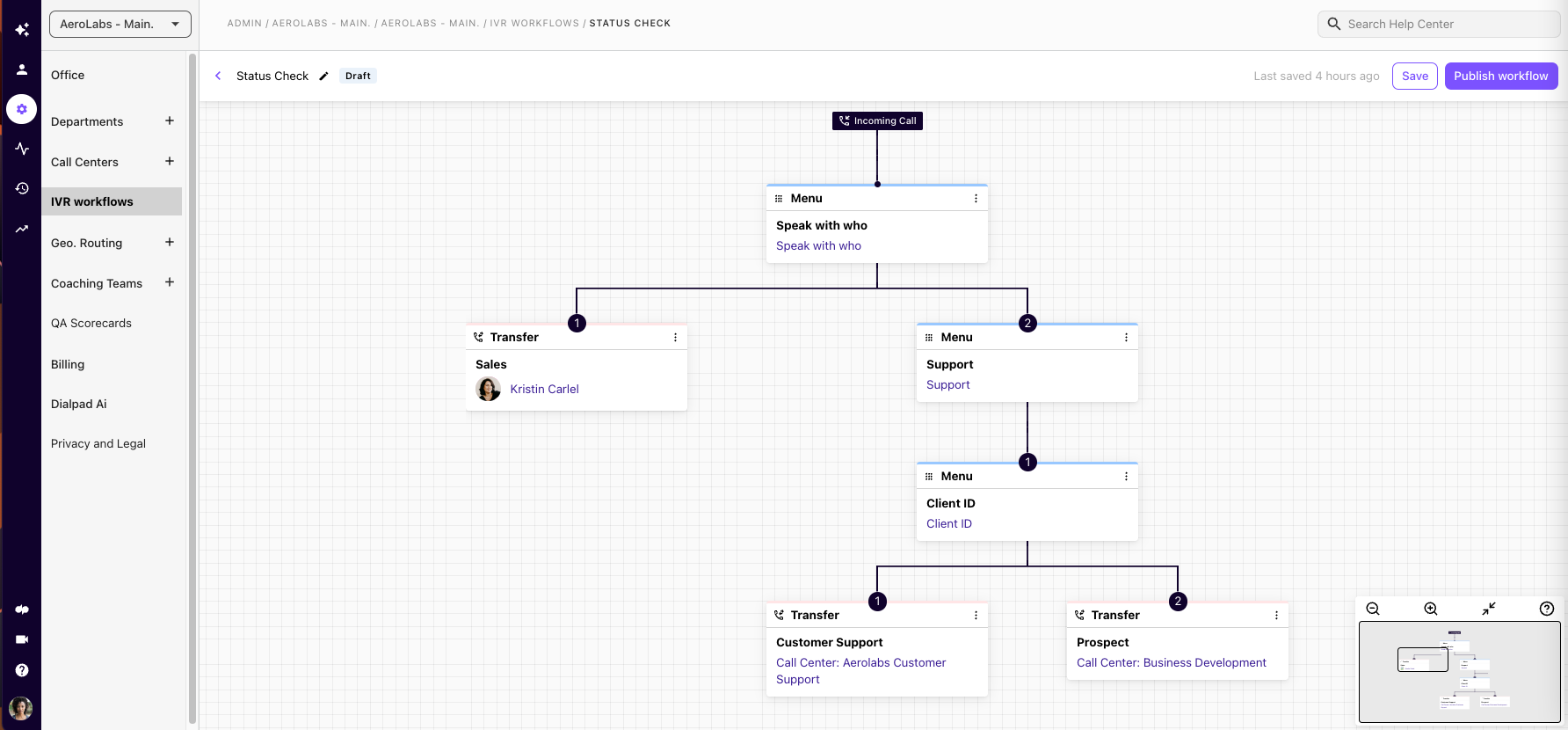
The Difference Between an Auto Attendant and IVR
Auto attendant refers to the greeting and routing portion of the larger interactive voice response (IVR) system, which has more advanced call distribution and routing capabilities.
The IVR connects to the company-wide phone system and databases that enable it to provide a wider range of self-service options with advanced call routing strategies, intelligent assistants, ring strategies, or more streamlined drag-and-drop call flow design tools. An auto attendant is a straightforward voice-based menu that greets and routes callers.
Put simply, an auto attendant is one part of an IVR system.
The Pros of Using Auto Attendants
An auto attendant is a great way to improve the first impression that customers get when they reach your business, but there are other benefits associated with using this type of system as well.
- Optimized call handling: A large number of calls that are routed using an attendant system will be handled simultaneously, resulting in higher customer satisfaction. It provides more professionalism in the first interaction that a customer has with your business as well.
- 24/7 customer access: Auto attendants will be able to route calls to another site or a voicemail when your office is not open. This saves you from losing business by not answering the phone or receiving calls after hours. With tools like Find Me/Follow Me (remote call forwarding), calls are even sent to mobile phones for agents who work remotely.
- Cost-effective: With an auto attendant-based routing system, you will not need to hire a secretary to take calls full-time. An auto attendant is included in a subscription and can do that work, saving you a few thousand dollars.
- Third-party app integration: CRM VoIP integration plays a major part in how customer relations are formed. These integrations allow an agent to bring up customer information while the call is being routed using the auto attendant, which helps the agent be better prepared for the incoming call.
The Cons of Using Auto Attendants
These systems are not perfect for every business. They do have their flaws and based on these, you may decide that you want a live person taking calls or a more complex routing system. Here are some of the areas where these systems fall behind.
- Impersonal initial interactions: Based on research done by Usabilla, 55% of customers prefer the comfort of speaking to an actual human being over interacting with a machine. With an attendant system, the customer does not use voice input to route callers properly, so some may hang up before they even get a chance to speak to an agent.
- Poor design causes abandonment: Organizing your menus takes a little finesse, and it’s easy to create a poor customer experience. In general, you don’t want long menus that could be confusing for the customer. Also, there should always be an option for the customer to reach an agent. Similarly to setting up IVR call flows, attendant menus must be easy to navigate to be effective.
- Wrong button presses: When a customer is impatient, or they simply press the wrong button, they may be routed to the wrong agent. This means that rerouting the call to the proper department will cost more time and money the attendant was designed to eliminate. It could also make the customer start back at the beginning of the menus, which is likely to cause annoyance before contact is made with an agent.
How to Choose an Auto Attendant Phone System
When selecting an auto attendant phone system for your business, consider the following tips:
- Note why customers call you
- Map out your IVR call flow
- Consider your budget
- Determine any integrations or analytics
- Compare Auto Attendant Features
1. Note Why Customers Call You
Before comparing auto attendant phone systems and their capabilities, it’s critical to know how your company will use yours. This means you must consider the reasons why customers call your company, which will help you determine the sub-menus, menu options, and announcements you’ll feature in your auto attendant recordings.
Customers may call for a variety of reasons, like:
- Customer support
- Technical support
- Product details
- Sales consultations and demos
- Product returns
- Billing information
2. Map Out Your IVR Call Flow
Once you’ve noted the reasons why customers call you, create a blueprint for your IVR call flow that sketches out which menu options your auto attendant will have. Determine which departments, queues, users, and announcements will branch off of your main menu, and envision which numbers you’ll assign to each department or queue.
Within your sketched call flow, map out submenus when necessary–such as different endpoints or users within the “technical support” branch. This IVR call flow sketch will help you evaluate how well auto attendant providers meet your needs.
If you don’t need submenus, you won’t need to purchase a “multi-level” auto attendant. You’ll just need a regular auto attendant, which will probably save some money.
3. Consider Your Budget
As you compare VoIP phone systems and their auto-attendant software, keep in mind your team’s phone system budget. Compare the other features that each plan bundles with an auto attendant–features like ring groups, call queues, and a drag-and-drop dial plan editor. These routing features will work complementarily with your auto attendant and will help you create the most dynamic IVR call flow.
4. Determine Any Integrations or Analytics
Consider if you’ll want to connect your auto attendant system to any external software–such as CRM systems, databases, or analytics platforms. This will help you determine which integrations and capabilities your auto attendant provider must offer to meet your needs.
- CRM system: Integrating your IVR system with CRM data will auto-update customer information about menu choices. Advanced auto attendant software can utilize customer data to provide personalized service.
- Database: Advanced phone system and call center software can integrate auto attendants with databases, such as those containing product inventory and customer information. This data increases the scope of functionality that your auto attendant can provide.
- Analytics: Many VoIP platforms have built-in analytics that track IVR menu choices, providing companies with data about how often each call path gets utilized. This helps companies understand their customers and refine their customer-service strategies.
5. Compare Auto Attendant Features
When you compare VoIP phone systems, note which features each auto attendant software includes.
Particularly, look for the following:
- Drag-and-drop designer: Look for a provider that offers a drag-and-drop auto attendant call flow designer, which provides a visual and user-friendly way to create call paths. Typically, software with this feature will allow you to create and save multiple auto attendants.
- Custom business hours: Look for a provider that allows you to automatically adjust your auto attendant menu options according to business hours
- Single-level or multi-level: A single-level auto attendant does not allow you to create submenus, while a multi-level auto attendant allows you to create two or more
- Self-service options: Some phone systems let you build your IVR with advanced self-service options, such as automated texts and passcodes. Note the types of automated functionality each auto attendant can provide to inbound callers.
The Best Auto Attendant Phone Systems
The providers listed below have easily configurable auto-attendant processes and are especially ideal for small businesses or startups.
RingCentral
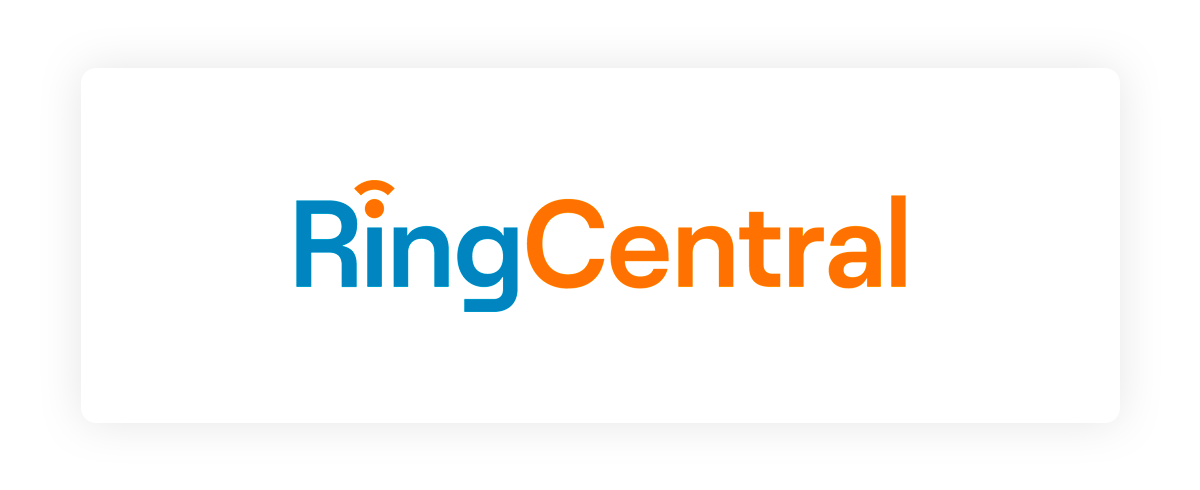
RingCentral is a UCaaS solution designed for businesses with a high daily call volume, and those who want to organize their inbound calls into queues.
Its multi-level auto attendant feature is available on all three RingCentral paid plans, which range from $20 to $35 monthly per user.
- Core ($20 monthly): Desktop and mobile app with Multi-level IVR, basic call queues, on-demand call recording, call monitoring
- Advanced ($25 monthly): Up to 1000 monthly toll-free minutes per account, advanced routing and call queues, on-demand call recording
- Ultra ($35 monthly): Up to 10,000 toll-free minutes per account
RingCentral Pros
- Local or toll-free numbers: Connect your auto attendant to toll-free numbers or local numbers based in countries around the globe.
- Multi-level IVR and call queues: RingCentral offers a multi-level IVR that connects smoothly with call queues, enabling a sophisticated routing system
- Analytics: The software includes advanced analytics, which provides useful information about call volumes and where customers most frequently route within your auto attendant menu
RingCentral Cons
- Learning curve: The RingCentral app comes with a lot of features, which may feel overwhelming for new users or those unfamiliar with cloud-based telephony
- Texting limitations: The provider limits the number of outbound texts each user can send per month, which is a drawback for teams that like to text customers
Best For
- Teams seeking well-rounded UCaaS: RingCentral not only has a multi-level auto attendant and queueing, but strong team collaboration features
- Teams with complex routing: RingCentral’s queuing and multi-level auto attendant enable teams to create intricate routing systems, for remote or in-person teams that want to provide customers with self-service
Nextiva
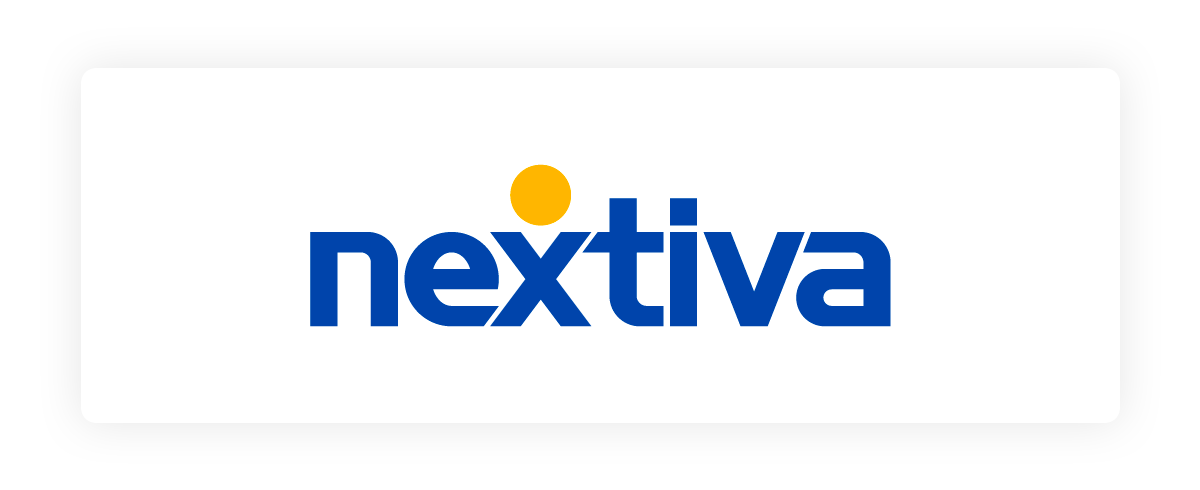
Nextiva is a unified communications platform with VoIP, SMS, team chat, and video conferencing. The provider has four paid plans from $18.95 to $32.95 monthly per user, which support unlimited calling in the US and Canada.
- Professional ($18.95 monthly): Desktop and mobile app, unlimited calling, basic auto attendant
- Professional ($22.95 monthly): Up to 3000 monthly toll-free minutes per account, multi-level auto attendant, Salesforce and Hubspot integrations
- Enterprise ($32.95 monthly): 12,500 toll-free minutes per account
Nextiva Pros
- Team collaboration tools: Team members can leave notes on calls and contacts, facilitating communication and task assignment
- Ring groups: All Nextiva plans include call groups, which enable you to build departments that can share inbound call responsibility. This feature serves as a great complement for auto attendants.
Nextiva Cons
- Only single-level auto attendant on basic plan: Nextiva’s lowest-tier Essential plan includes just a single-level auto attendant, so teams seeking submenus must opt for the Professional plan
- No queuing: While Nextiva has ring groups, the platform does not offer built-in queueing
Best For
- Teams prioritizing toll-free calling: Each Nextiva plan includes a large allotment of monthly toll-free minutes, ranging from 1,500 to 12,500 monthly toll-free minutes per account
- Well-rounded UCaaS: Nextiva supports unlimited 1:1 chat, 3 team chat channels with collaboration features, and team presence–making it a solid option for not only routing, but team collaboration
Grasshopper
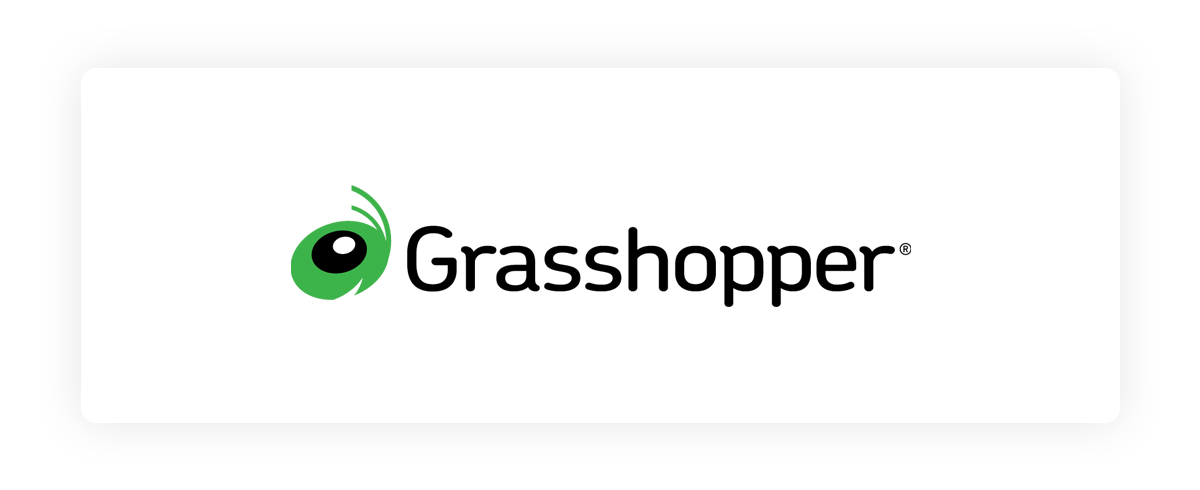
Grasshopper is a VoIP provider designed for small teams or solopreneurs needing an affordable phone system. Plans include unlimited calling and SMS within the US, plus toll-free and local phone numbers from area codes across the United States.
Grasshopper pricing plans range from $26 to $80 monthly per account. Each plan includes a mobile and desktop app, voicemail transcription, call forwarding, and call transfer. Grasshopper includes multiple phone-line extensions with each plan, which you can use to create an auto attendant.
- True Solo: ($14/mo per account): 1 user, 1 phone number, 1 extension
- Solo Plus ($28/mo per account): unlimited users, 1 phone number, 3 extensions
- Partner ($46/mo per account): unlimited users, 3 phone numbers and 6 extensions
- Small Business ($80/mo per account): unlimited users, 5 phone numbers, unlimited extensions
Grasshopper Pros
- Simple phone system: With just SMS and voice, Grasshopper’s desktop and mobile app interface is spacious and easy to understand
- Unlimited texting in the US: While many alternatives limit the number of SMS texts each user can send per month, Grasshopper supports unlimited texting within the US
Grasshopper Cons
- Difficult to configure auto attendant: Grasshopper doesn’t have a built-in auto attendant design tool. Rather, users have to forward calls between extensions and phone numbers, pairing these with voicemail greetings to build an auto attendant routing system. We found this process to be very complicated.
- No collaboration tools: Grasshopper lacks video conferencing and team chat, making it a poor option for team collaboration
Best For
- Texting and calling: Grasshopper offers unlimited texting and calling in the US plus basic call controls like call forwarding and transfers. It works great for US-based teams that want a simple phone system
- Shared phone numbers: The account-based pricing structure offers a preset number of phone numbers and extensions, but unlimited users, per plan. This makes Grasshopper a great option for teams that plan to share phone numbers between multiple users.
Vonage
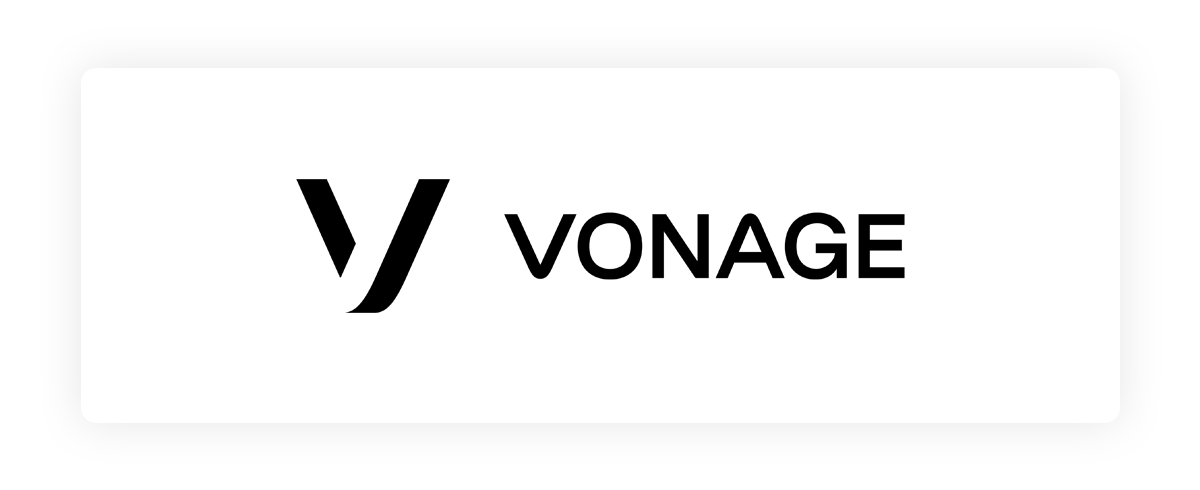
Vonage is a VoIP phone system with video, SMS, team chat, and basic telephony features–an auto attendant, call groups, and visual voicemail.
Vonage Unified Communications pricing ranges from $19.99 to $39.99 monthly per user.
- Mobile ($19.99 monthly): Mobile and desktop apps, call transfer and forwarding, unlimited calling and texting in the United States
- Premium ($29.99 monthly): Adds multi-level auto attendant, CRM integrations
- Advanced ($39.99 monthly): Adds call groups, visual voicemail, and 15 hours of on-demand call recording
Vonage Pros
- Call groups: Vonage’s Premium plan includes call groups, enabling your team to group agents into departments that act like queues
- Analytics: Vonage’s Premium and Advanced plans feature analytics and reporting, which provide information about user activity and call volume over time
Vonage Cons
- No auto attendant on basic plan: Vonage’s Mobile plan does not include auto attendant functionality
- Expensive: Vonage’s plans are pricier than many alternatives, especially when you consider that Vonage reserves some basic features–like call groups and voicemail transcription–for higher-tier plans
Best For
- In-person teams: The Vonage phone system connects smoothly with most VoI desk phones from many providers–YeaStar, Ooma, Cisco, and more. This makes it a good option for in-person companies and call centers.
- Simple video meetings: Vonage’s video meetings host up to 200 participants, with easy-to-use host controls and features like chat and screen sharing
8x8
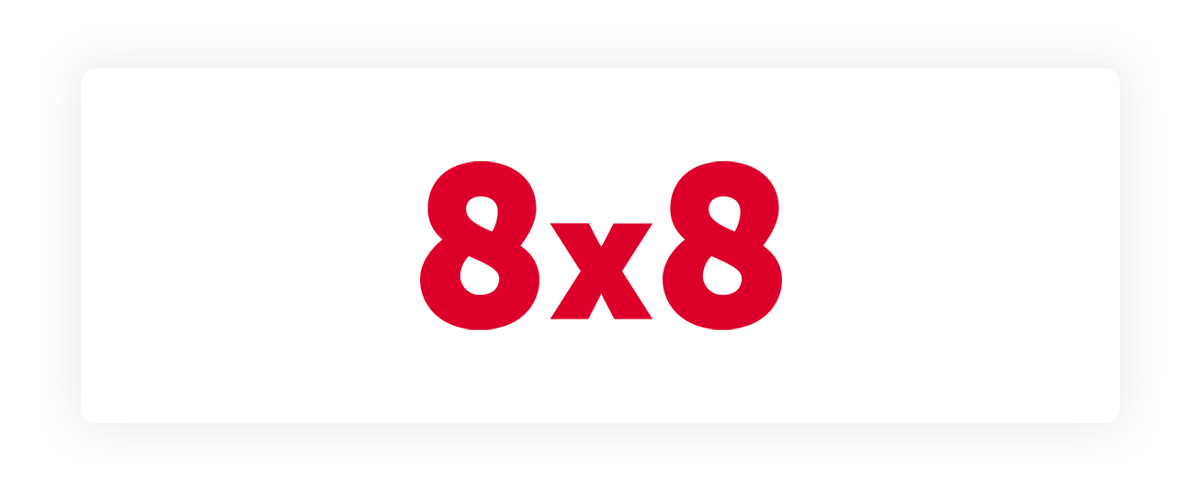
8x8 is a unified communications platform with VoIP, SMS, team chat, large video meetings, and plans that support a large unlimited international calling area. Both 8x8 plans have quote-based pricing requiring you to contact them for an estimate, but each plan includes a multi-level auto attendant.
- X2: Desktop and mobile app, unlimited calling to 14 countries, multi-level auto attendant, ring groups, call transfer and forwarding, call queues, voicemail transcription, AI-enhanced speech analytics, CRM integrations
- X4: Expands unlimited calling to 48 countries, adds call monitoring
8x8 Pros
- Routing and queueing: All 8x8 plans include not only multi-level IVR but call queueing, enabling users to build an advanced routing system on any plan
- Collaboration tools: 8x8 video meetings and team chat include tools that facilitate team communication. Video conferences have interactive features like hand raising, polls, and breakout rooms.
8x8 Cons
- Restrictions on unlimited calling: The X2 plan supports unlimited calling to 14 countries, but of these 14 countries, many only allow calls to landline and VoIp numbers–not mobile. For truly unrestricted international calling, users must purchase the X4 plan.
- Lack of price transparency: 8x8’s lack of public pricing makes it difficult for teams to compare the platform’s value with other providers
Best For
- Teams that call internationally: 8x8’s two plans offer 14- and 18-country unlimited calling areas, respectively. For teams that frequently call outside national borders, these plans may offer an excellent value.
- Large teams: 8x8 video meetings support up to 500 participants–more than any alternative on our list–making it a great option for large and even enterprise-size teams
3CX
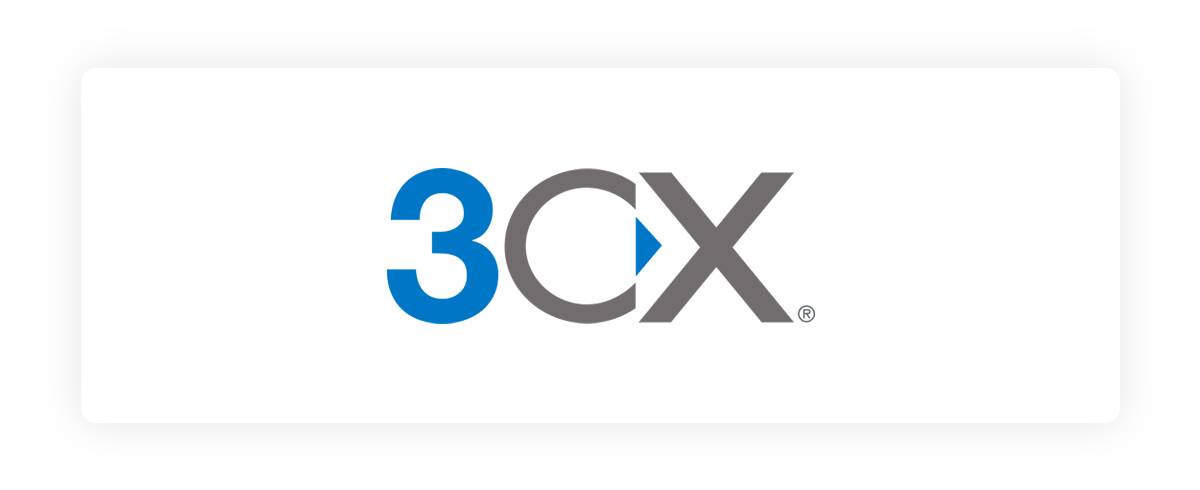
3CX’s business phone system includes a multi-level auto attendant on each plan, alongside live team chat, SMS, and video conferencing. Uniquely, 3CX supports both cloud-hosted and on-premises PBX systems where users supply their own SIP trunk. Small companies with their own SIP trunk can even use 3CX’s free plan, which includes ring groups and a welcome message.
3CX offers four plans, charged per system. Aside from the free plan, all 3CX plans include multi-level auto attendant.
- Free ($0 monthly): Bring your own SIP trunk, desktop and mobile apps, business hours routing, ring groups, welcome message
- Small Business ($275 per system with 20 users): Call queues, multi-level IVR, call monitoring
- Professional ($265 per system on-premises, $515 hosted): Adds CRM integrations and call recording
- Enterprise ($325 per system on-premises, $575 hosted): Adds skills-based routing
3CX Pros
- Routing tools: 3CX offers a solid suite of routing tools including call queues, ring groups, multi-level auto attendant, and skill-based routing
- Call monitoring: Supervisors can listen in quietly to calls, whisper private guidance to agents, or barge in to join calls
3CX Cons
- Expensive hosted option: 3CX offers your choice between a self-hosted or a cloud-hosted solution, but the cloud-hosted plans are pricier than those of alternative providers
- Outdated interface: While using 3CX, we felt that the platform’s desktop interface felt outdated and old-fashioned, which made it less appealing to use
Best For
- On-premise teams: 3CX uniquely offers the option for on-premise installation, which your team can self-host using an IP PBX system. The platform connects to a wide variety of VoIP desk phones.
- Skills-based routing: 3CX enables you to evaluate agents by various skills and proficiencies and route inbound calls to agents based on not only availability, but how well the agent’s skill matches the caller’s need
Ooma

Ooma is a business phone service provider offering video, SMS, and unlimited VoIP within the US, Canada, and Mexico. An auto attendant is included with every plan and supports talk-to-text, which allows you to type menu options and announcements.
Ooma Office supports three plans:
- Essentials ($19.95 monthly): Mobile app only, auto attendant, ring groups, multi-device ringing, a direct dial number per user, a toll-free number per account
- Pro ($24.95 monthly): Adds desktop app and call recording
- Pro Plus ($29.95 monthly): Adds call queueing, CRM integrations, shared voicemail boxes, and advanced call management with 5 auto-attendant schedules
Ooma Office Pros
- IVR on all plans: Ooma offers its auto attendant and IVR functionality on all plans, providing a cost-effective option for those who only need the $19.95 monthly Essentials plan
- Analytics: Pro and Pro Plus plans include analytics that covers agent activity, channel usage, and call volume over time. Ooma’s analytics include a live leaderboard to increase team engagement
Ooma Office Cons
- No team chat: Ooma’s platform includes video but no team chat, limiting its utility as a team collaboration platform
- No desktop app on the Essentials plan: Only the Pro and Pro Plus plans include a desktop app, meaning users on the Essentials plan are limited to a mobile app only
Best For
- Teams that call Mexico: Ooma Office includes unlimited calling to the US, Canada, and Mexico–with the latter being a unique option that some providers don’t include
- Hybrid teams: Ooma’s Pro Plus plan includes hot desking, which enables users to jump between desk phones and workspaces when they’re in the office
Phone.com
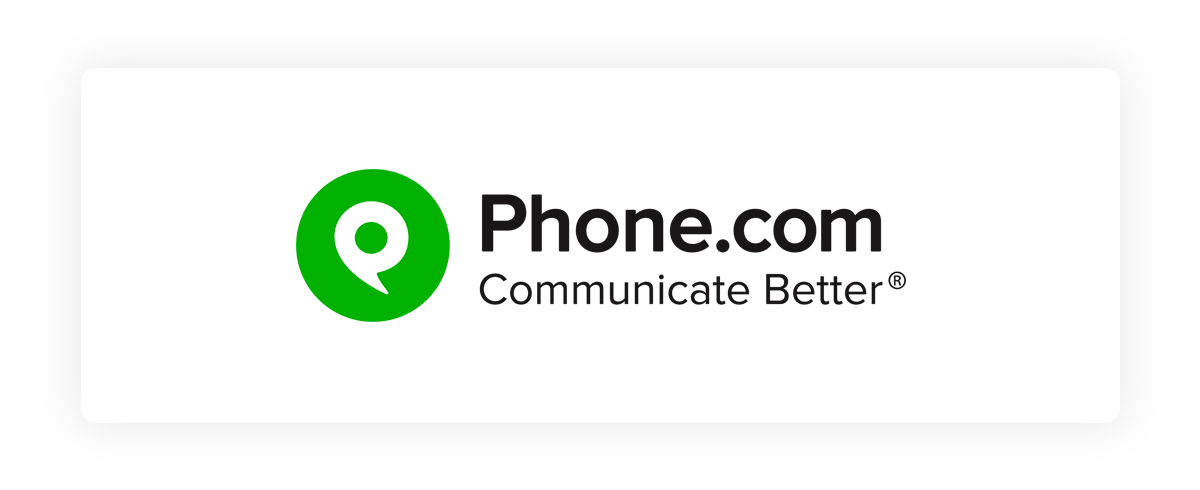
Phone.com is a UCaaS platform with VoIP, video, and texting. The provider offers plans with unlimited minutes or pooled minutes, making it a cost-effective option for companies with low call volumes. Auto attendants come with each plan, with the unique ability for users to mix and match plans.
- Basic ($12.74 monthly): Mobile and web apps, 500 pooled minutes per account, one phone number per user, 10-participant video conferencing, auto attendant, call queues, call handling rules
- Plus ($18.69 monthly): Unlimited calling in the United States and much of Canada, voicemail transcription, SMS texting
- Pro ($27.19 monthly): Adds call analytics and unlimited call recording\
Phone.com Pros
- Mix-and-match pricing: Phone.com eagles teams to mix Basic, Pro, and plans for pricing flexibility
- Routing features: Plans include not only an auto attendant but call queueing, enabling intricate and custom routing systems for inbound calls
Phone.com Cons
- No team chat: The phone.com system does not include team chat capabilities, which limits the software’s potential as a collaboration tool
- Video conferencing participants: While the Pro plan supports up to 100 participants during video meetings, the Plus plan supports only 25. This forces medium and enterprise-sized teams to upgrade to the Pro plan, if they want to use video conferencing with large groups.
Best For
- Teams with low call volumes: The Basic plan offers 500 pooled minutes and one phone number per account–which offers a cost-effective option for teams that need phone service but don’t have large monthly call volumes
- Teams that plan to live stream: Phone.com video meetings include not only whiteboards but live streaming to YouTube, unlocking unique use cases like tutorials and workshops
GoTo Connect

GoTo Connect is a UCaaS system that features an auto attendant in all its cloud-based PBX solutions. The automated system answers calls with a custom greeting to reflect your brand or the time of year. Further, the Standard plan supports unlimited calling to an incredible 50+ countries.
GoTo Connect comes in two pricing plans:
- Basic ($29 monthly per user): Desktop and mobile app, unlimited calling in the US and Canada, smart call routing, one auto attendant with a recorded greeting, one ring group, one call queue, and one customizable dial plan
- Standard ($39 monthly per user): 50+ country unlimited calling area, unlimited auto attendants, ring groups, dial plans, and call queues
GoTo Connect Pros
- Drag-and-drop designer: GoTo Connect includes a drag-and-drop designer to build smart call-routing systems that unify queues, ring groups, users, and voicemails
- Real-time analytics: The Standard plan includes real-time analytics with caller hold time reports, providing insights about each caller’s experience, IVR menu pattern, and queue activity
GoTo Connect Cons
- Expensive plans: GoTo’s cheapest plan costs $29, which is over $10 more than some competitors charge for their basic plan
- SMS limitations: The Basic and Standard plans limit each user’s SMS credits to 40 and 80 SMS per month, respectively
Best For
- Teams that call internationally: The Standard plan supports unlimited calling to over 50 countries, providing a wider unlimited calling area than any other plan on our list
- Large phone systems: GoTo’s Standard plan supports unlimited access to useful phone-system tools–queues, ring groups, IVR menus, and dial plans–enabling large teams to build as massive and intricate of a phone system as they need
Dialpad

Dialpad is a cloud communications platform with VoIP, team chat, small-team video conferencing, and SMS. The platform stands out with its use of AI features, such as live coaching for on-call agents and automated post-meeting summaries.
In addition to a multi-level auto attendant on each plan, Dialpad allows users to record or upload custom greetings and offers custom call routing strategies to ensure callers reach the right department. Dialpad offers 3 pricing plans, ranging from $15 to over $25 monthly per user.
- Standard ($15 monthly): Desktop and mobile apps, AI-powered call transcriptions, multi-level auto attendant, custom call routing, voicemail transcription, real-time analytics, 3 ring groups
- Pro ($25 monthly): 25 ring groups, local numbers in over 70 countries, CRM integrations
- Enterprise (custom pricing): Unlimited ring groups
Dialpad Pros
- AI features: Dialpad integrates artificial intelligence into multiple parts of its phone system, including video meetings and live AI call transcriptions. These tools streamline collaboration and support on-call agents.
- Analytics: All Dialpad plans include advanced real-time analytics, including queue and agent activity. For $15 monthly, the Pro plan provides excellent value with this functionality.
Dialpad Cons
- Small video meeting capacity: Dialpad video meetings only support 10 users, which could be restrictive for large teams
- Limited integrations: Dialpad only integrates with 11 apps, while many competitors integrate with dozens or even hundreds of third-party software systems
Best For
- Teams seeking to establish an international presence: Dialpad offers business phone numbers from 70 countries around the globe–a much wider variety than most other providers
- Intricate routing needs: Dialpad offers custom call routing options, enabling teams to choose the order or method in which calls route to agents. Route calls by longest idle, fixed order, round robin, or simultaneous ring.
Are Auto-Attendant Phone Systems IVR Alternatives?
Before you select an auto-attendant provider from our list, understand that they don’t do everything. An IVR solution or a call center solution is better for your organization if you need:
- Self-service options for customers
- CSATs (customer satisfaction surveys)
- Menus that are accessible by voice response
- Omnichannel routing
Auto attendants are easy to implement, shorten customer wait times, and connect callers to the right department. They are also something to consider for small businesses that don’t need overly complex menus for their customers.

